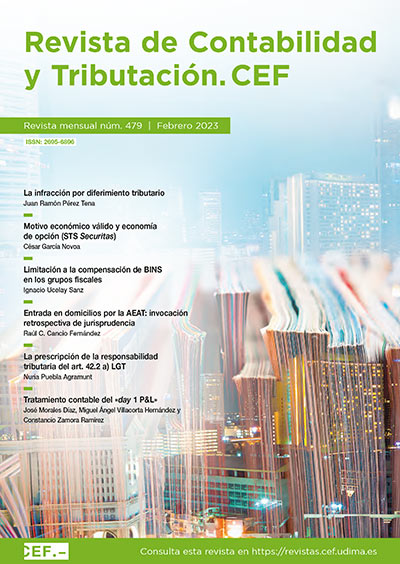Tratamiento contable del «day 1 P&L» en los instrumentos financieros. Análisis empírico
DOI:
https://doi.org/10.51302/rcyt.2023.11553Palabras clave:
resultado del primer día, day 1 P&L, instrumentos financieros, NIIF 9, NIIF 13Resumen
El problema del resultado del primer día o «day 1 P&L» se refiere al reconocimiento contable de la posible diferencia entre el precio de transacción de un instrumento financiero y su valor razonable inicial estimado por la entidad. Se trata de un problema muy común en la práctica, pero escasamente desarrollado en la literatura contable y, además, sobre el que existe escasa información en los desgloses de los estados financieros de las entidades.
Bajo la NIIF 9, el resultado del primer día solamente puede reconocerse en la cuenta de pérdidas y ganancias en el reconocimiento inicial si el instrumento cotiza en un mercado activo o se valora exclusivamente con inputs observables. En caso contrario, debe diferirse. La norma no se pronuncia con relación a cómo llevar a cabo este diferimiento. En consecuencia, las entidades deben desarrollar su propia política contable. En este trabajo, analizamos esta problemática contable con detalle y llevamos a cabo una investigación empírica de los desgloses relacionados con la misma en los estados financieros de las entidades financieras españolas y europeas.
Descargas
Citas
Altamuro, J. y Zhang, H. (2013). The financial reporting of fair value based on managerial inputs versus market inputs: evidence from mortgage servicing rights. Review of Accounting Studies, 18(3), 833-858.
Aurori, M. H., Bellalah, N. H. y Nguyem, D. K. (2012). Relevance of Fair Value Accounting for Financial Instruments: Some French Evidence. International Journal of Business, 17(2), 209-220.
Ball, R., Li, X. y Shivakumar, L. (2015). Contractibility and transparency of financial statement information prepared under IFRS: Evidence from debt contracts around IFRS adoption. Journal of Accounting Research, 53(5), 915-963.
Beatty, A. y Liao, S. (2014). Financial accounting in the banking industry: A review of the empirical literature. Journal of Accounting and Economics, 58(2-3), 339-383. DOI: https://doi.org/10.2139/ssrn.2346752
Deloitte. (2021). iGAAP 2021. Croner-i.
Drago, D., Mazzuca, M. y Trina, R. (2013). Do loans fair value affect market value? Evidence from European banks. Journal of Financial Regulation and Compliance, 21(2), 108-120. DOI: https://doi.org/10.1108/13581981311315532
Evans, M. E., Hodder, L. y Hopkins, P. E. (2014). The Predictive Ability of Fair Values for Future Financial Performance of Commercial Banks and the Relation of Predictive Ability to Banks’ Share Prices. Contemporary Accounting Research, 31(1), 13-44. DOI: https://doi.org/10.1111/1911-3846.12028
EY. (2022). International GAAP 2022. Wiley.
Fiechter, P. y Novotny-Farkas, Z. (2017). The impact of the institutional environment on the value relevance of fair values. Review of Accounting Studies, 22(1), 392-429. DOI: https://doi.org/10.1007/s11142-016-9378-7.
Freeman, W., Well, P. y Wyatt, A. (2017). Measurement Model or Asset Type: Evidence from an Evaluation of the Relevance of Financial Assets. Abacus, 53(2), 180-210. DOI: https://doi.org/10.1111/abac.12108
Ghio, A., Filip, A. y Jeny, A. (2018). Fair Value Disclosures and Fair Value Hierarchy. DOI: https://doi.org/10.13140/RG.2.2.11458.43208
Goh, B. W., Li, D., Ng, J. y Yong, K. O. (2015). Market pricing of banks’ fair value assets reported under SFAS 157 since the 2008 financial crisis. Journal of Accounting and Public Policy, 34(2), 129-145. DOI: https://doi.org/10.1016/j.jaccpubpol.2014.12.002
He, X., Wong, T. J. y Young, D. (2012). Challenges for implementation of fair value accounting in emerging markets: Evidence from China. Contemporary Accounting Research, 29(2), 538-562.
KPMG. (2020). Insights into IFRS 2020/21. Thomson Reuters.
Morales, J. y Zamora, R. (2019). Contabilidad de Derivados y Coberturas bajo NIIF. Editorial Lefevre.
Müller, M. A., Riedl, E. J. y Sellhorn, T. (2015). Recognition versus disclosure of fair values. The Accounting Review, 90(6), 2.411-2.447.
O’Hanlon, J., Hashim, N., y Li, W. (2015). Expected-Loss-Based Accounting for the Impairment of Financial Instruments: the FASB and IASB IFRS 9 Approaches. European Parliament, Brussels. https://op.europa.eu/en/publication-detail/-/publication/0e486c41-3bd9-11e9-8d04-01aa75ed71a1/language-en
Ohlson, J. A. (1980). Financial Ratios and the Probabilistic Prediction of Bankruptcy. Journal of Accounting Research, 18(1), 109-131.
Ohlson, J. A. (1995). Earnings, Book Values, and Dividends in Equity Valuation. Contemporary Accounting Research, 11(2), 661-687.
Panaretou, A., Shackleton, M. B. y Taylor, P. A. (2013). Corporate risk management and hedge accounting. Contemporary accounting research, 30(1), 116-139.
Siekkinen, J. (2016). Value relevance of fair values in different investor protection environments. Accounting Forum, 40(1), 1-15. DOI: https://doi.org/10.1016/j.accfor.2015.11.001
Song, C. J., Thomas, W. B. y Yi, H. (2010). Value Relevance of FAS 157 Fair Value Hierarchy Information and the Impact of Corporate Governance Mechanisms. The Accounting Review, 85(4), 1.375-1.410. DOI: https://doi.org/10.2139/ssrn.1198142
Tama-Sweet, I. y Zhang, L. (2015). The value relevance of fair value financial assets during and after the 2008 financial crisis: evidence from the banking industry. Journal of Finance and Bank Management, 3(1), 11-24. DOI: https://doi.org/10.15640/jfbm.v3n1a2
Zamora-Ramírez, C. y Morales-Díaz, J. (2018). The Use of Fair Value Measurement in Financial Reporting: A Literature Review. Studies of Applied Economics, 36(2), 489-514, DOI: https://doi.org/10.25115/eea.v36i2.2540















